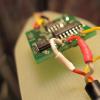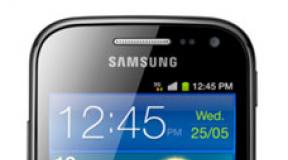Copying the system to ssd. Features and rules for completely cloning hard drive data from HDD to SSD. Algorithm, process and actions
But what to do if you don’t want to buy the same Acronis, you’re too lazy to tinker with all sorts of clonzillas, and make a complete clone of the system disk for the purpose of, say, transferring it to a new one (or HDD), or maybe, let’s say, putting it on a shelf as a static backup?
Let's get a look.
How to make a full copy of a disk - SSD or HDD
Well, let's figure it out. We will talk, as you understand from the subtitle, about the HDClone program, which has a free version, supports the Russian language, is incredibly easy to use, and also has pleasant functionality.


When you first start, they will unobtrusively tell you that you can get more goodies if you buy one of the extended versions of the program. You can safely ignore this information (or study it on the developer’s website) and click the “Close” button.
The main window of the program is simple, concise and provides access to its functionality. The functionality in the free version is simple:
- Disk cloning (we will consider this);
- Creating a disk image;
- Creating backups (including backups not of the entire disk, but of partitions);
- Testing tool;
- Sector-by-sector disk browsing tool.
Everything is done extremely simply and literally in two clicks, but let’s still consider, for example, creating a full copy of one disk to another (let’s say we need to transfer Windows from HDD to SSD), for which we click on the appropriate button.
In the first step, we will be asked to select the source disk or partition that we want to copy.
It is logical that at the second stage they will be asked to select the disk (or partition) to which we want to make a copy.
Now you will be prompted to configure partitions. Most often, this is not necessary and a tick is enough" Resize partitions proportionally", but if suddenly you need some adjustments, you can do it here.

It goes without saying that a warning will appear stating that the data on the disk where cloning will be performed will be completely deleted. It is worth taking it seriously so as not to lose anything valuable.
Next, if you did everything correctly (however, even if you did it incorrectly), the disk cloning process will begin. During it you will be reminded once again that there is paid versions, which allow you to copy faster:

Time, of course, is money, but with such a process and difference, I still choose money, especially since while the process is going on, you can do other useful things.


At the end of the process, you will be asked to adjust the partition (this is indeed necessary). If you don’t understand, then you can use the automatic option, but for those with hands, there is a manual setting.

At the end you will be able to see the result, as well as see some details. At this point the process can be considered completed.

Additional functionality
What else? Well, perhaps I’ll say that in the main window of the program, in the lower right corner, you can call up the settings menu (by clicking on the wrench icon) and create a bootable USB/CD/DVD media, which is no more difficult to manage than the program itself, and also look at the instructions and do other little things.
The SpeedTest section, as mentioned, allows you to test disks for the speed of the media in sequential and random reading (although in my opinion, this is not enough and it is better to use it).
Well, DiskView will allow you to look indecently deeply, right into the very sectors of any HDD/SSD media. If, of course, you know why it is needed.
That's probably all for now.
Let's move on to the afterword.
Afterword
This is such a wonderful tool that, it seems to me, will be useful to anyone who cares about their data and/or who has ever faced the need to move from disk to disk (to the same SSD).
As always, if you have any questions, thoughts, additions, etc., then welcome to comment on this article.
Hello, friends! I often had the opportunity to transfer Windows 7 and Windows 8 from a simple HDD to an SSD. I mainly used the following programs: Acronis True Image, Paragon Migrate OS to SSD, Paragon Home Expert 12 and AOMEI Partition Assistant Home Edition. The longest, but most interesting, way to transfer Windows 7 from HDD to SSD using the tools built into Windows.
- If you are interested in the article, visit where they are collected all publications on our site on the very interesting topic of transferring operating systems from one storage device to another.
The easiest and surprisingly fast waytransfer Windows 7 from HDD to SSDusing the program Paragon Migrate OS to SSD , with the help of this program I suggest that you today transfer the system to an SSD.
The program is paid, it costs a fortune 390 rubles. If you have Windows 8, then only latest version Paragon Migrate OS to SSD 3.0 programs.
Website http://www.paragon.ru/home/migrate-OS-to-SSD

Important Note: If you have Paragon Home Expert 12 installed, then the Paragon Migrate OS to SSD utility is included in the package of this program.

If you want to transfer Windows 7 from HDD to SSD using Paragon Home Expert 12, go to the end of this article, there are short instructions there.
After the transfer operating system from HDD to SSD, you need to check the correct alignment of the disk partitions relative to the SSD architecture. Aligned partitions ensure maximum performance, speed and longevity of your solid state SSD drive, believe me, this is very important. We will check the correctness of the partition alignment free utility AS SSD Benchmark.
How to migrate Windows 7 from HDD to SSD using Paragon Migrate OS to SSD program
So, pay attention to the Disk Management window of my computer, there is a 250 GB hard drive, divided into two partitions, on one of them - drive (C:) there is a Windows 7 operating system, we will transfer it to a 120 GB SSD solid state drive, representing unallocated space.

Launch the Paragon Migrate OS to SSD program. Next.

The program automatically found my SSD drive and is ready to transfer the operating system. Pay attention to the item “Use all available space for the partition with OS”, be sure to check the box here and all the space on the solid-state drive will be allocated to create one new disk (C:) with the transferred Windows. After all, solid-state drives are used mainly only for installing the operating system.
If you click on “Please select what folders should be copied”, then you can select the folders you need to copy. I need the whole Windows, so I'll leave everything as is. 

Click on the Copy button.

A suspiciously short migration process occurs without any reboots.

I couldn’t help but remember the good old Acronis True Image, where you had to create an image of the operating system, then deploy it to an SSD, although Acronis works flawlessly, it takes several times longer.
While we were talking about Acronis, the Paragon Migrate OS to SSD program had already transferred our Windows 7 to an SSD. The final window in which we are offered to boot from the SSD. Let's reboot.

Now you need to enter the BIOS and set to boot from the SSD. Select Boot Menu (F8).

Using the arrows on the keyboard, select our solid-state drive and press Enter. The computer is booting from the SSD.

Note: What I like about UEFI BIOS is that it has its own bootloader, which accommodates all existing bootloaders and will never get confused in them. The UEFI BIOS remembers the last operating system you loaded and will load it exactly next time. Switching between operating systems (no matter how many of them you have installed) is simple, fast and error-free.
If you have a regular BIOS, then the transfer should also occur without problems. The only thing you need to do is find in it the parameter responsible for the primacy of hard drives Hard Disk Drives (AMI BIOS) or Hard Disk Boot Priority (AWARD BIOS) and set your SSD as the first device. How to find these parameters can be found in.


I think you managed it and booted from the SSD into the transferred system. We go to Disk Management and see this picture - the system has been transferred.
Many older (or cheaper) Windows laptops come with traditional mechanical hard drives, which are quite outdated and slow these days. Upgrading to a new, ultra-fast solid state drive (or SSD) is the most reliable way speed up your old computer. There's one problem: moving your Windows installations can be tricky, especially because SSDs are often smaller than their traditional hard drive counterparts.
However, there is a way to move your Windows 7, 8 or 10 installation to an SSD without Windows reinstallation. Requires a few extra steps but much less time.
What do you need to migrate your system from hdd to ssd?
Besides your SSD, you'll need a few other things to make this process work. Here's what we recommend:
- How to connect your SSD to your computer. if you have desktop computer, you can simply install the new SSD along with the old one hard drive on the same machine to clone it. However, if you're using a laptop, this is usually not possible, so you'll need to buy something like a SATA to USB cable (shown on the right), which will allow you to connect a 2.5-inch HDD or SDD to your laptop via USB. You can also install your SSD in an external enclosure hard drive before starting the migration process, although it takes a little longer.
- A copy of EaseUS Todo Backup. Its free version has all the features needed to complete the task before us, so download the free version and install it just like any other Windows program. WARNING. Make sure you click the "Customize" link on the "Additional Installation" page. software" and uncheck all the boxes, otherwise EaseUS will try to install some related crapware along with the disk cloning tool.
- Data backup. We can't stress this enough. It's downright stupid to start messing with your hard drive without a backup. Check out our guide to backup computer and make sure you have a complete backup of your important data before proceeding.
- Windows System Recovery Disk. It's a tool anyway. To avoid damage to your main boot entry you will be able to appear on the Windows repair disk and fix it in minutes. Follow these instructions for Windows 7 and these instructions for Windows 8 or 10. Be sure to print a copy of our bootloader repair guide so you can fix it if you need to. No. Do it. Burn this CD and print this article - if you find it, it will save you the trouble of finding another computer to create a bootable CD.
Now let's move on to the instructions on how to How to transfer a system from HDD to SSD?
Step One: Remove Your Current HDD
If you're upgrading to a drive that's smaller than your current one, which is often the case if you're upgrading to an SSD, you'll run into issues right off the bat. There is not enough space on your destination disk for all your files!
To check the capacity of each drive, connect the SSD to your computer and wait for it to appear in Windows Explorer. Right click on each drive and select " Properties" In the two screenshots below, you can see that the used space of our old drive (left) (141 GB) is more than what our new drive (right) (118 GB) can hold.


You'll probably encounter something similar. Therefore, before transferring data, you need to clean your current hard drive.
Start by deleting any files you don't need. This means that old movies, TV shows, TV series, music, old backups and everything else take up a lot of space. Remove any programs you no longer use, then run Disk Cleanup to get rid of any other unwanted file on your system. You can even run a program like CCleaner to make sure everything is squeaky clean.
This will help a little, but in some cases it may not be enough. If you manage to delete files, this means that you will need to find a new place to store personal files such as your photos, documents, movies, music, etc. because they will not fit in your new drive.
You have several options:
- External hard drive: if you have external hard disk(which you don't use for important backups!), it's time to use it. You will need to move all your precious files to it to shrink your partition Windows.
- Second internal drive: This isn't usually an option for many laptop users, but if you're a desktop user, you can buy a big, cheap one extra hard drive and transfer your files to this. You can even move the location of your documents, music, and other folders after migration, so Windows never misses a beat.
- Cloud storage: If you don't have additional hard drives, you can move these additional files to a cloud solution such as Dropbox or OneDrive. Just keep in mind that if you don't have your personal files stored in the cloud, it may take a while (like days or even weeks) to download them, so just be prepared. Once you've moved all your stuff to your cloud folders, you can unmount them to free up disk space.
Remember because your new hard The drive may be smaller than your old one, you'll need to find a new permanent location to store them, so choose the solution that works best for you in the long run.
Step Two: Update the SSD Firmware

SSD is, technologically, a new product on the market. Some of the earliest generation SSDs had various errors and problems that were only banished with significant firmware updates.
Each drive company has a different methodology for updating the firmware - some require a reboot using a special CD to flash the drive, and some allow you to flash the firmware from Windows if the drive is not the primary OS. OCZ, for example, has one of the aforementioned Windows tools (see screenshot above). Visit your drive manufacturer's website to learn more about your drive and how to update the firmware. Now is the best time to update the firmware as there is zero risk of data loss since you haven't copied anything yet.
As you have already noticed, transferring a system from hdd to ssd is very simple. The main thing is to follow the instructions.
Step Three: Cloning Your Drive Using EaseUS Todo Backup
Now it's time for the main event. Launch the EaseUS app and tap "Clone" on the home screen. This application will help transfer system from HDD to SSD.

First select the source drive. This will be your current system Windows disk. Our system disk consists of three partitions: active boot partition, actual Windows partition and recovery partition. We want to clone all three, so we're just going to put a check next to the hard drive to make sure they're all selected. Click Next to continue.

Now you need to select the SSD as the destination. In our case, this is "hard drive 4" containing 119 GB of unallocated space. Make sure you select the correct drive or you may lose your data!
Place the check on it and then check the " Optimize for SSD", which will give you the best performance out of your final Windows installation.


EaseUS will show you what your resulting drive will look like. In some cases, you may need to make some adjustments. For example, on my SSD, EaseUS wanted to make the boot and recovery partitions much larger, even though they contain less than a gigabyte of data. I would rather have this space on my main Windows partition, so I needed to resize it before proceeding.

To resize these sections, first select it and then drag the handles that appear between sections, just as you would resize the Explorer window.

I then resized the main Windows partition to fill the rest of the empty space.

Depending on the location of your drive, you may have to change things differently. When you're done, click OK to continue. Double check that everything looks correct and click Continue to begin the cloning operation.

If you receive the following warning, click OK to continue.

The actual length of the operation will depend on how large your source disk is, as well as the speed of the storage media and your computer. For us it took about 5 minutes. Transfer system from HDD to SSD It turned out to be even faster than we thought.
If any errors occur during this process, you may have to use a third-party defragmentation tool on your current system disk- in some cases system files sitting at the end of the disk can make resizing difficult.

When the operation is completed, click "Done".
As you can see in the following screenshot, our new system drive is already showing up in Explorer. All that's left is to start using it.

To do this, the following steps are quite simple. Turn off your computer, remove old disk and install the new one in the same place. Restart your computer and it will automatically boot from your new drive.
If you're using a desktop computer and want to keep the old drive in place—perhaps as a backup or storage device—then you'll need to boot into your system BIOS (usually by holding down the "Erase" button until the logo appears Windows boot) From there you will need to specify your BIOS on the new drive as the first one to boot. You can follow our USB boot instructions for this - just select your new hard drive instead of a disk or USB drive in the instructions.
Either way, when you reboot, you should find that your SSD is now listed as the C: drive. (If it's not, double check that you followed the above steps correctly.)
Step Four: Place the Finishing Touches on Your SSD
Once your new system drive is up and running, you'll need to do a few final things to make sure everything is working as it should and in tip-top shape. Here's what we recommend.
Make sure TRIM is enabled. TRIM is a special set of commands that help SSDs manage empty disk space efficiently (if you're interested, you can read more here). Open command line and enter the following command:
fsutil behavior query DisableDeleteNotify
This long command has a very simple output: either 0 or 1. If you get 1, TRIM is not enabled. If you get 0, TRIM is enabled. If you need to enable it, enter the following command:
fsutil behavior set DisableNotify 0
Make sure defragmentation is disabled. There is no need to defragment the SSD, and in fact it is not recommended. Windows should handle this automatically, but it doesn't hurt to check. Open the Start menu and type dfrgui in the start box to open Disk Defragmenter. Click the Schedule button, then click Select Disks. Uncheck "SSD" (this should be your C: drive) and click OK.
Recover personal files. Here you have to make some decisions. While it's possible that your documents and maybe even your photos will fit on your new SSD, it's unlikely that your videos and music files will, meaning you'll need to keep them somewhere else, like a second internal drive (you By the way, you can use your old drive for this) or an external hard drive.
If you want, you can even specify your special custom folders to this new location, so Windows will always look for them first for the corresponding files. Simply right-click on your Documents, Music, or other custom folders and select Properties > Location > Move... to move them.

A word about other SSD things and tricks. Be careful in setting these simple fixes. Many SSD guides suggest improving performance by disabling Superfetch (there is dubious evidence that this setting improves performance at all) or disabling the page file (which reduces the number of writes to the SSD, but can cause programs to crash if they run out of RAM). These days, you won't have to work hard to keep your SSD running at its best.
conclusions
The tweaks suggested here will definitely improve performance and will not have any negative side effects. Use caution when deploying tweaks that you find in other guides and forum posts. And remember: modern SSDs may have limited writes, but they are much less limited than older style SSDs. Talk about avoiding things that write to your drive is pretty outdated. Chances are you'll replace your computer before you get close to wearing out your SSD!
Congratulations! You've cloned your drive, saved yourself hours of reinstalling Windows and tweaking your applications, and you're ready to enjoy a faster, quieter system drive.
If you still have any questions about how to transfer a system from HDD to SSD, write them in the comment form on our website.
Upgrading a computer does not always mean replacing it completely. It is common practice to add “slats” random access memory or replace the video card. The affordability of solid state drives has opened new opportunity hardware configuration updates. You can speed up your PC by replacing the traditional hard drive with an SSD. If you have enough RAM, this can give a noticeable increase in speed. However, it is not at all necessary to completely reinstall the system. Today we will figure out how to transfer Windows to an SSD without losing data.
Microsoft has provided tools for all occasions in its operating system. Users are not even aware of many of them. Let's look at how to transfer Windows 10 to an SSD drive without resorting to third-party OS programs.
The migration process requires the use extra hard disk on which a backup copy of the current system will be created. If it is available, you can proceed to preparing the transfer. Turn on the computer and call context menu"Start" button and select the marked item.
Initialization of a new drive in the system will begin with the selection of a partition style. All 64-bit Windows versions, starting with Vista, are able to boot from GPT partitions and store data on them. The presence of UEFI on a computer indicates its support at the hardware level. Thus, the choice is made between two options:
- BIOS + 32-bit Windows - MBR;
- UEFI + 64-bit Windows - GPT.
Having decided on the markup, we confirm the choice.

In the window of the standard disk management utility that opens, we see the following picture. The intermediate disk that is needed to create a copy has been identified, but is not yet formatted or partitioned. Right-click on it and bring up the context menu. Select the only active option, marked with a frame.

A wizard opens, following the prompts of which we will make the drive suitable for further use.

We won’t change anything, we’ll create a single volume for the entire disk.

If desired, at this stage you can change the letter by which the drive is designated. By default, the next one in order in the Latin alphabet is set.

Let's set the name of the new volume.


As you can see in the screenshot, our Newssd appeared in the list of available ones.

Open the control panel and select the designated section.

In the quick navigation area, we need a menu for creating an OS image.

The system automatically detects the connected Newssd as a storage location.


Clicking the ready button starts the image creation process.

When finished, the system will prompt you to create a disk. disaster recovery. If there is no installation media, you can agree.

You will need a blank flash drive with a capacity of at least 8 GB or a DVD blank.
As a result, we have three disks: an old HDD with Windows, a clean, unpartitioned SSD, and a backup copy on intermediate media. To perform the transfer, remove the old hard drive and install a new one in its place. Boot from the installation media and select recovery mode. The OS installer will deploy the saved backup. After the next restart, we get a ready-made OS with all the settings and documents on the solid-state drive.
During our work, we only needed classic tools that are present in any version of the Microsoft OS. Transferring Windows 7 to an SSD is done in the same way.
Using special software
As we have seen, you can clone the system to a new drive using built-in tools. The process is complicated only by the need to create an intermediate medium with the image. Any third party program To transfer Windows to an SSD, you can do without it. Let's look at some of them so that the user can independently choose the method that is convenient for him.
Macrium Reflect
The user has access to several editions that differ in functionality. We will use Free version, which does not require additional registration. A web installer is downloaded from the developer's website. The parameters required for a particular system are set after it is launched.

Additional options are marked with an arrow. Having opened them, select the system bit size and the option suitable for loading. The choice of distribution edition is available in the drop-down menu, which is marked with the number “2”.

Having expanded it, you can choose a clean installer or with recovery system components.

Uncheck the box responsible for automatically starting the installation of the program and proceed to downloading.

The Macrium Reflect interface is in English. Russian language is not provided. At startup, connected drives are automatically scanned. In the main window we are interested in the option marked with a frame that allows direct cloning.

The number “1” indicates advanced settings, which are shown in a separate screenshot. Click on the hyperlink and select the final destination drive indicated by the arrow.

IN additional options you don't have to change anything. Integrity checks are checked file system and SSD TRIM connection.

The cloning window is divided into two parts. At the top on existing system The partitions of the current disk are checked. Clicking on the framed hyperlink transfers the selected areas to the new drive.

The last stage before launch. The screenshot shows that the old structure has been completely transferred to the new drive. Click the “Next” button to begin transferring Windows 10 to another hard drive.

At the final stage, the program will prompt us to create a schedule for regular cloning and will show information about the amount of data transferred. The last window before creating a copy will warn you that existing data on the destination drive will be overwritten.

The duration of the transfer depends on the storage capacity and does not require user intervention.
Acronis True Image
The program is shareware and has trial period in 30 days. Completely translated into Russian, so there are no difficulties with its use.

The on-the-fly cloning option only works in full version. Without it, you can transfer Windows 10 to an SSD in a way similar to the system one. Create a backup copy and deploy a ready-to-use system from it on a new disk. This feature is implemented much simpler and is performed in literally two steps. In the main window, select the appropriate section, indicate external storage and start execution. You can use a portable USB drive as an intermediate one.

To transfer to a new disk, select the recovery option, mark the destination media and start unpacking the image.

At this stage you can configure Extra options, which are needed for cloning. Select the marked item to adjust the recovery.

Check the source box and select the destination drive in the drop-down menu. We start the recovery procedure.

The process runs in background. No user intervention or reboot is required.
Paragon Migrate OS to SSD
Migrate OS is the only “absolutely” paid program from those described. To use it, you will have to shell out 790₽. It can work both under Windows and without installation, from standalone media. In the latter case, the interface does not have a Russian language. You can transfer Windows 7 from HDD to SSD using it directly, without the intermediate step of creating a backup copy. All actions are performed in several steps using the Migration Assistant.

At the first stage, we select the current OS intended for cloning to new media.

The next step is to select the target disk to which the migration will be performed.

We receive a final information summary containing the starting and ending points of the “relocation” operation. The checkbox indicated by the arrow is the default. The user is prompted to automatically make changes to the download manager. Leaving it in this position, we will immediately boot from the new system disk.

Clicking the “Finish” button completes the preliminary “virtual transfer” operation.

This window displays the source and destination disk. The screenshot shows that the program created an exact copy. Changes are applied using the “Apply” button located in the upper left corner.

We receive the last warning, after which it is no longer possible to cancel the operation.

The migration process is completed automatic reboot OS. We are entering an already “moved” SSD system. After making sure that all data and settings are in place, you can turn off the HDD or use it to store information as storage media without an OS.
Finally
As we could see during the review process, third-party software allows the user to move the OS in a more convenient format than the built-in tools. At the same time, the necessary functionality of paid and free versions is almost on the same level. To perform a one-time operation, you can use any one.
Do not forget that creating a copy of the system allows the user to quickly “move”, but at the same time transfers all the accumulated over time Windows operation"diseases". If the OS has been used for a long time, you should consider a “clean” installation.
SSD drives are becoming more and more popular. This is due to an increase in their reliability, a decrease in cost and an improvement in the characteristics that they possess. Therefore, it is great for installing an operating system. But in order not to reinstall it again, you can transfer Windows 10 from HDD to SSD, saving all the data.
Why transfer?
If you decide to use an SSD as a drive to store data (photos, video or audio files), it's a moot point since these devices have a limited overwrite limit. Active use will very quickly destroy it, unlike the HDD, which has been serving me for over 10 years and is still in excellent condition. But it has an interface SATA connections II, small buffer size and low response time. Therefore, it was decided to purchase a solid-state drive to transfer Windows 10 to it.
SSD drives are great for OS installation because they have the following advantages:
- high read/write speed;
- silent operation;
- low level of heat generation.
In addition, Windows is “static files” that do not require constant rewriting, but only reading. Therefore, if you install the OS on a solid-state drive, this will speed up its operation several times and at the same time the resource of the device itself will be used very slowly.
Another reason why I decided to install an SSD in my PC was participation in the insider program.
Microsoft releases a new build for Fast Ring approximately once a week. It took about 1-1.5 hours to install it on an old HDD. If you add time to this Windows startup- about 1.5-2 minutes, it becomes clear that the solution has long been obvious.
SSD selection
Details on how to choose an SSD disk for a computer are described in the article “”. In my case, three parameters were priority:
- number of rewrite cycles before failure;
- memory type;
- manufacturer.
As for capacity, if you are going to use the SSD only to install Windows 10, choose models from 120 GB and larger.
Why shouldn't you buy 64 GB drives?
There are several reasons.
- For stable and normal operation of the SSD disk, it must have up to 20% free space of the total volume. If you use a 64 GB model (in fact, its volume will be slightly smaller - 58-60 GB), only 40-45 GB will be available for active use. Microsoft's recommendations for free disk space for Windows 10 are 16 GB for 32-bit and 20 GB for 64-bit OS. And this is already half of the specified space.
- After installing a new build or Windows updates 10, a copy of the old OS remains on the system disk, which is used during recovery. This is an additional 15-20 GB.
- In addition to the browser and audio and video players, the average user uses various programs and utilities. Installing them also requires quite a lot of space (for me it’s about 8 GB). For a gamer or person involved in video processing, you will need even more free space on the system disk.
Therefore in modern conditions The minimum size of the SSD drive used in the device to install the OS is 120 GB.
Connection and setup
The transfer process will be shown using a solid state drive as an example. 
- Turn off the computer → disconnect it from the network by unplugging the plug from the socket → press and hold the PC power button for 4 seconds (this will completely cut off the power to the device).
- Open the case and install the SSD. The new buildings have compartments for SSD installation in a 2.5-inch form factor. Older models do not have them, so you can use a special adapter frame.

- Connect power and SATA cable to the SSD → close the case.
- Turn on your computer → enter BIOS → set the AHCI SSD mode → save changes and launch Windows 10.

- RMB on the Start menu → Disk Management.

Important! The table at the bottom of the window will display the connected SSD drive. It will be marked in black and labeled “Not distributed.”

- RMB on SSD → Create simple volume → Next.

- Set the maximum simple volume size → Next.

- Select the volume letter → Next.

- Set the radio button to “Format this volume as follows” → leave all default values → Next → Finish.

After this, Explorer will display a new drive under the letter that you set in the settings.
Transfer Windows 10 to SSD
To transfer Windows 10 to a solid-state drive, we used a program that has a wide range of functions. The choice fell on it due to the fact that the SSD included a key for free activation. However, the program is paid, so it is not suitable for everyone.
There are other programs (paid and free) that can be used to transfer (clone/copy) a Windows partition to another drive:
- Seagate DiscWizard (works if the device has a Seagate drive installed);
- Samsung Data Migration (designed to work with solid state drives Samsung);
- Macrium Reflect free program for cloning the entire disk or its individual parts, which has an English-language interface;
- Paragon Drive Copy is a paid program that has wide functionality.
The interface of all programs is different, but the operating algorithm is the same: they transfer data from one disk to another while maintaining all settings. There is no need to study instructions for their operation - everything is done so that the user intuitively understands what he is doing.
- Launch Acronis True Image → Tools section → Clone disk.

- Select the cloning mode: automatic or manual.
Good to know! In order not to worry that you will do something wrong, select the “automatic” mode and the program itself will transfer all the data from one disk to another. In this case, the SSD drive must be no less than the amount of data stored on the HDD. To configure transfer settings, select the “manual” setting.
I chose the "manual" cloning mode to transfer only the OS.

- Specify the source disk from which data will be cloned.

- Specify the drive to transfer information to.

- Exclude files that do not need to be cloned to the SSD. To transfer only the OS disk, check the boxes for files on other disks to exclude.

Important! The process of calculating information can take a long time (about 15-20 minutes).
- Change the disk structure if necessary. In my case, it was left unchanged.

- Review all source data → Proceed.

After completing the preliminary operations, the program will ask you to restart your computer. Then, instead of starting the OS, a window will open Acronis programs True Image which will display the cloning process. Wait until the operation is completed and then the computer turns off.
Selecting the primary drive in BIOS

Setting up the OS after the transfer
More details on how to configure an SSD disk after installation on a computer are described in the article “”. In general, you need to check the following parameters:
- whether the TRIM function is enabled;
- Is disk defragmentation disabled (it is not needed due to the way solid-state drives operate);
- Is file indexing disabled?
As for the hibernation file, many advise disabling it in order to reduce the amount of information written to the SSD drive to extend its “life.” I didn’t turn it off because I often use this mode at work. But you can do as you see fit.
Please note that due to the settings that I specified during cloning, disks will be created on the solid-state drive, as was the case on the HDD. You can merge them in the Disk Management utility.
- RMB on the Start menu → Disk Management → select SSD drive.
- RMB on an empty disk on a solid-state drive → Format.

- RMB on this disk → Delete volume → Yes.

- RMB on this disk → Delete partition → Yes.

Remove Windows files 10 placed on the HDD by formatting this disk. This will eliminate confusion in the future and free up space for storing files.
Results
| Parameter | Before | After |
|---|---|---|
| Windows 10 boot time | 1.5-2 minutes | 17-20 seconds |
| Windows 10 update time | 1-1.5 hours | 20-30 minutes |
| Program/application response time | low (3-15 seconds) | high (1-5 seconds) |
| Data copying speed (within separate disk) | 50 Mb/s | 300 Mb/s |
In addition, in the Winaero WEI tool, which calculates OS performance (similar to how the system score is determined in Windows 7), the “Primary Hard Drive” indicator increased from 5.6 to 7.95. (you can find out how else to determine OS performance in the article “Determining and increasing performance Windows computer 10 “Pleasant” surprises
The warranty period is 3 years with a total number of written bytes of 113 TB. The volume is quite large. BUT!
Every day, much more information is written to disk than it might seem. This service information, wear leveling algorithms. Thanks to them, the same SSD memory blocks are not constantly rewritten. Periodically, unused (or rarely used) files are moved to areas of the drive that are actively used. Free place, which appeared after the redistribution, is then used to record new information. This is a cyclical process that happens constantly.
As a result, in the worst case, 1 GB of useful data accounts for 1.5 GB of recorded information. Plus data cache in browsers and other information. As a result, on average, about 15 GB of information is recorded on my SSD every day. But even with such indicators, the resource of the solid-state drive will last approximately 15-18 years.
For people who actively write/erase data, this figure will be significantly lower. But even in this case, the relevance of the purchased SSD drive model will disappear faster before it fails. So stop believing the myth that SSDs are unreliable! In modern conditions, they are the best choice for installing Windows 10.
Read also...
- Cadaques in Spain. My review and photo. Cadaques, Catalonia Cadaques Spain how to get there from Barcelona
- Cart for an online store at the front or Writing modular javascript
- Falling snow on jQuery or html New Year greeting card template
- Where to see what version of Android is installed on an Honor and Huawei phone How to find out the Huawei serial number



















